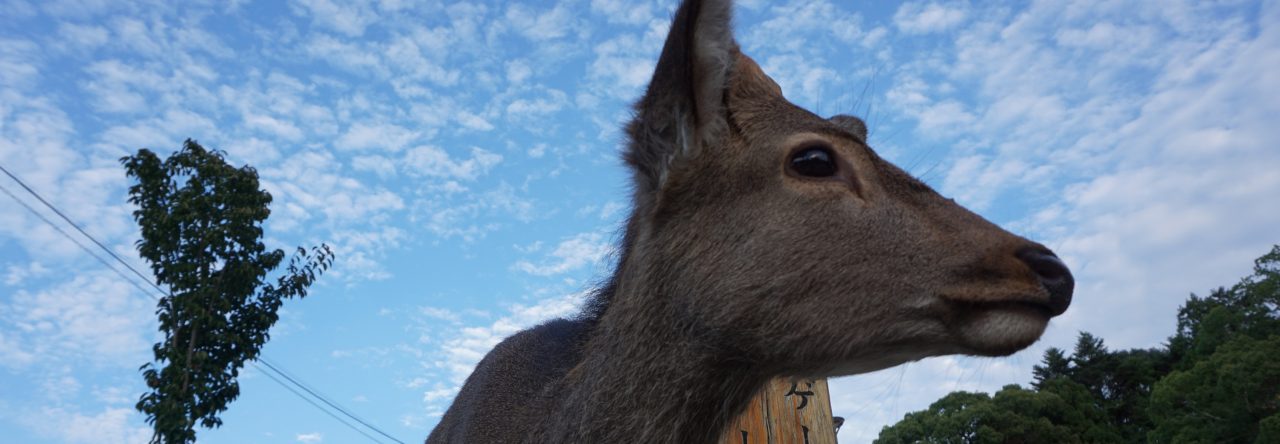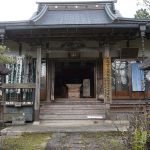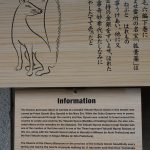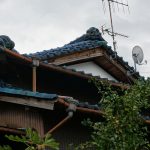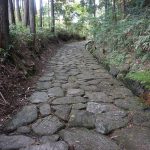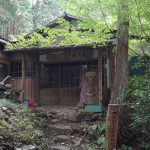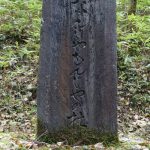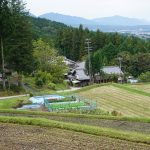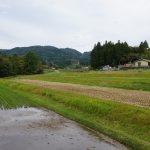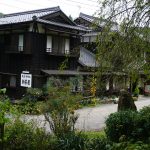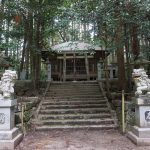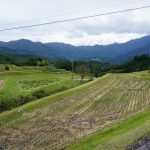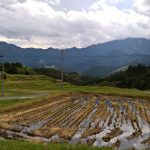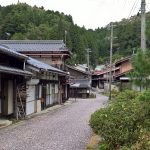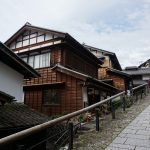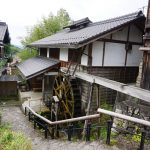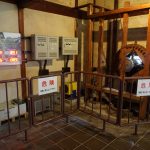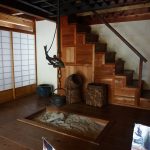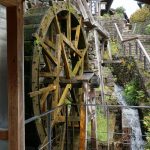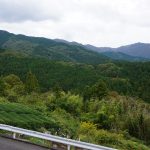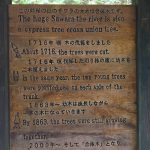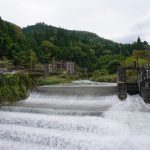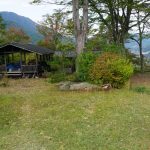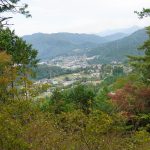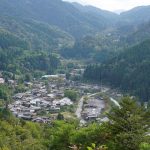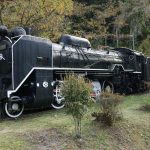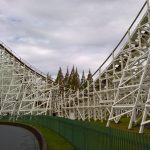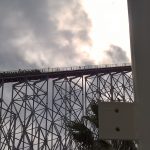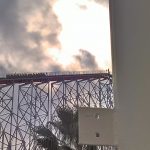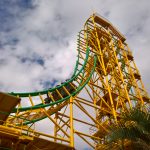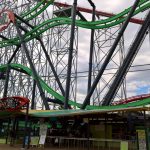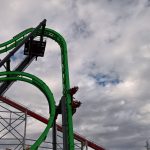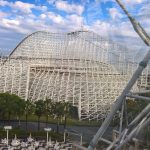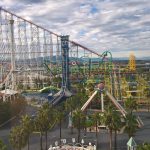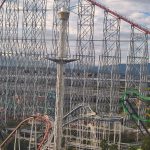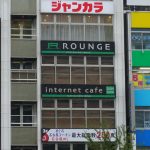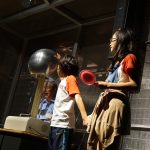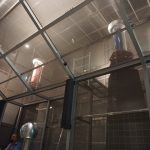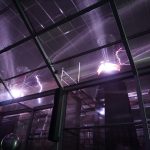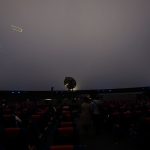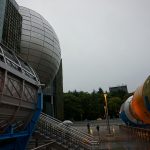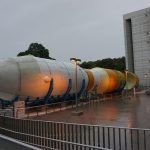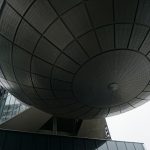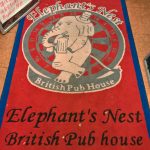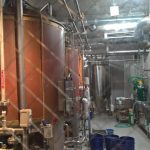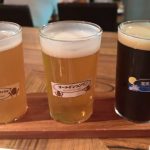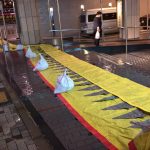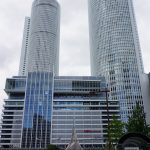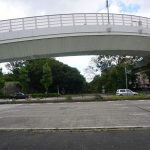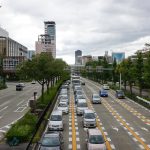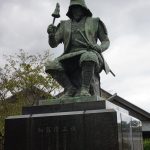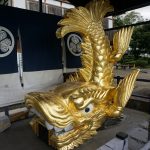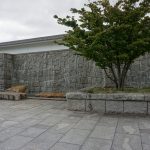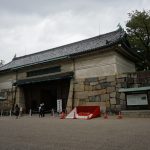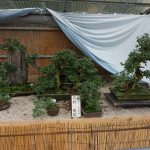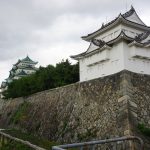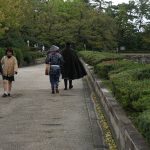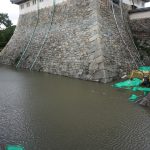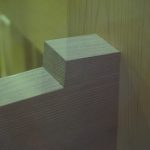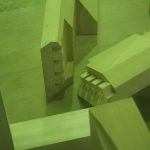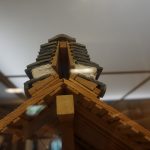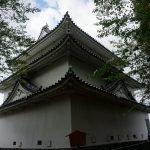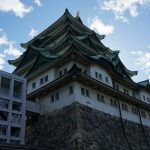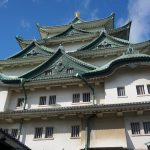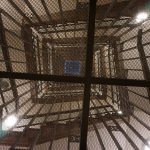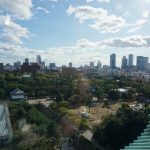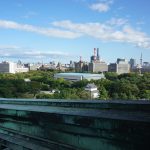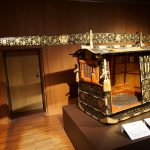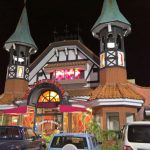Tuesday 24th
Up bright and early to catch the bus from Nakatsugawa station out to the start of my hike. A chilly start, but I decided on shorts and sandals as it was likely to warm up through the day – and this was a ~25km hike day. In the bus queue were a number of westerners – I definitely heard Spanish – and also a local all kitted out for hike probably in his 60’s. He didn’t speak much English but we chatted for a while, it seems he was gradually working his way along the Nakasendo one section at a time.
 The Nakasendo was one of the five routes of the Edo period, and one of two routes (the other being the Tokaido) linking Edo (now Tokyo, or ‘Eastern Capital’) and Kyoto, the old imperial capital. Running 534km across country, it passed through 69 staging posts, or post towns, and was used by the feudal lords and their retinues. Nowadays much of it runs along modern highways, but there are stretches which feel like very little has changed for hundreds of years – and the route I was following between Ochiai and Nagiso is one of the prettiest.
The Nakasendo was one of the five routes of the Edo period, and one of two routes (the other being the Tokaido) linking Edo (now Tokyo, or ‘Eastern Capital’) and Kyoto, the old imperial capital. Running 534km across country, it passed through 69 staging posts, or post towns, and was used by the feudal lords and their retinues. Nowadays much of it runs along modern highways, but there are stretches which feel like very little has changed for hundreds of years – and the route I was following between Ochiai and Nagiso is one of the prettiest.
 I left the bus sooner than my travelling companions – they were probably heading to Magome, the first of two post towns on this section of the way, but I wanted to walk one of the few remaining stone paved sections first. After hiking up a steep road and passing a small temple, and some houses with beautiful blue tiled roofs, I found the paved section winding up through the forest ahead. Well preserved, with a stone drainage channel down one side, it was strange to think the samurai had trodden these paths hundreds of years ago – and that things would not have looked much different.
I left the bus sooner than my travelling companions – they were probably heading to Magome, the first of two post towns on this section of the way, but I wanted to walk one of the few remaining stone paved sections first. After hiking up a steep road and passing a small temple, and some houses with beautiful blue tiled roofs, I found the paved section winding up through the forest ahead. Well preserved, with a stone drainage channel down one side, it was strange to think the samurai had trodden these paths hundreds of years ago – and that things would not have looked much different.
- Dead end!
 Arriving at the end of the old paved section I moved on to asphalt which was specially coloured – this marks the route of the old Nakasendo. As I walked I met the Japanese man I’d spoken to in Nakatusgawa, who politely asked if he could take my photo before he carried on his way. Past rice paddies, spectacular mountain views and fish ponds – and a Shiba Inu who did his duty as a good guard dog! – I arrived in Magome.
Arriving at the end of the old paved section I moved on to asphalt which was specially coloured – this marks the route of the old Nakasendo. As I walked I met the Japanese man I’d spoken to in Nakatusgawa, who politely asked if he could take my photo before he carried on his way. Past rice paddies, spectacular mountain views and fish ponds – and a Shiba Inu who did his duty as a good guard dog! – I arrived in Magome.
 The town stretched up a long rising street, looking like something straight out of the Edo period – apart from the tourists! A wooden waterwheel outside one of the houses had been adapted with a generator to supply electricity to the house, the interior was a fascinating contrast – the generator and monitoring equipment on one side, and an irori (traditional Japanese sunken hearth, or firepit) on the other. A stop for a chestnut and vanilla ice cream provided a welcome cool down.
The town stretched up a long rising street, looking like something straight out of the Edo period – apart from the tourists! A wooden waterwheel outside one of the houses had been adapted with a generator to supply electricity to the house, the interior was a fascinating contrast – the generator and monitoring equipment on one side, and an irori (traditional Japanese sunken hearth, or firepit) on the other. A stop for a chestnut and vanilla ice cream provided a welcome cool down.
The views were quite stunning:
 As I hiked on and upwards to the Magome pass at 800m (having started at 300m), I saw a brass bell hung from a post, with a sign saying “Ring the bell hard, Against Bears”. I’d seen some locals hiking with small bear bells hung from their rucksacks, this was obviously another deterrent – so I rang it hard and loud. The Japanese black bear tends to steer clear of humans – as long as they hear you approaching!
As I hiked on and upwards to the Magome pass at 800m (having started at 300m), I saw a brass bell hung from a post, with a sign saying “Ring the bell hard, Against Bears”. I’d seen some locals hiking with small bear bells hung from their rucksacks, this was obviously another deterrent – so I rang it hard and loud. The Japanese black bear tends to steer clear of humans – as long as they hear you approaching!
 After heading downwards past massive cypress and tight packed stands of slimmer trees, I met with a couple of the locals – a cat with her kittens, as I arrived in the second post town, Tsumago. Another beautifully preserved old town, with an impressive river flowing through and hydroelectric power generation as well.
After heading downwards past massive cypress and tight packed stands of slimmer trees, I met with a couple of the locals – a cat with her kittens, as I arrived in the second post town, Tsumago. Another beautifully preserved old town, with an impressive river flowing through and hydroelectric power generation as well.
A short detour brought me to a couple of impressive waterfalls – Odakimedaki, or male waterfall and female waterfall:
 On past Tsumago, and there were signs for the remains of Tsumago castle. At the foot of the path leading up the hill, I thought I’d just missed treading on a large beetle – on closer inspection it turned out to be a land crab, only a few centimetres across, who didn’t seem to pleased to see me!
On past Tsumago, and there were signs for the remains of Tsumago castle. At the foot of the path leading up the hill, I thought I’d just missed treading on a large beetle – on closer inspection it turned out to be a land crab, only a few centimetres across, who didn’t seem to pleased to see me!
There wasn’t anything left of the original castle buildings, but the views down to either side of the hill were grand. Stopped to have an apple, and a chat with a couple of guys who I’d passed a few times on the trail – they were from Barcelona, and were in their second week of their travels.
On approaching Nagiso station, passed another well preserved old steam engine, parked on a siding. Train back to Nagoya, and subway to Sakae for a well earned nights sleep at hotel The B.
Wednesday 25th
 While browsing information about Nagoya, I’d come across a place called Nagashima Spa Land – a water park, spa resort, and amusement park with some epic rollercoasters. So a train to Kuwana then a local bus brought me there, and as we crossed a large river I saw the towering coasters in the distance – and thought ‘what am I letting myself in for!’.
While browsing information about Nagoya, I’d come across a place called Nagashima Spa Land – a water park, spa resort, and amusement park with some epic rollercoasters. So a train to Kuwana then a local bus brought me there, and as we crossed a large river I saw the towering coasters in the distance – and thought ‘what am I letting myself in for!’.
As it was the off season, some of the rides were closed for maintenance. I started with the big one – Steel Dragon 2000 – ranked 7th tallest coaster in the world, with a 93.5m drop from the first peak. Without a doubt, the fastest and most extreme coaster I’ve ever ridden – awesome! Followed this by some of the others – Acrobat (a ‘flying’ coaster where you lie face down), Ultra Twister (a corkscrew affair), then Star Flyer (a 64m tall chair-o-plane with impressive views) and finally Aurora Wheel (their 90m tall ferris wheel).
The guys shown below on the Steel Dragon asked me where I was from – then said ‘welcome to Japan’ and high fived me – very friendly folk.
Bus back to Kuwana – packed in like sardines with a load of teens in school uniform – then trains to Nagoya and onward to Naha.
